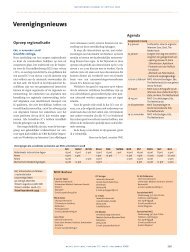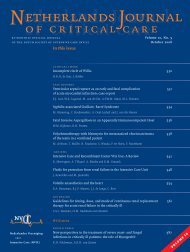Netherlands Journal of Critical Care
Netherlands Journal of Critical Care - NJCC
Netherlands Journal of Critical Care - NJCC
Create successful ePaper yourself
Turn your PDF publications into a flip-book with our unique Google optimized e-Paper software.
<strong>Netherlands</strong> <strong>Journal</strong> <strong>of</strong> <strong>Critical</strong> <strong>Care</strong><br />
Accepted January 2013<br />
CASE REPORT<br />
Gastric dilatation and perforation due to binge eating:<br />
a case report<br />
J.A.M. Heijneman 1 , R. Tahmassian 2 , T. Karsten 3 , E.R. van der Vorm 4 , I.A. Meynaar 1<br />
1<br />
Department <strong>of</strong> Intensive care, Reinier de Graaf Hospital, Delft, The <strong>Netherlands</strong><br />
2<br />
Department <strong>of</strong> Clinical Pharmacy, Reinier de Graaf Hospital, Delft, The <strong>Netherlands</strong><br />
3<br />
Department <strong>of</strong> Surgery, Reinier de Graaf Hospital, Delft, The <strong>Netherlands</strong><br />
4<br />
Department <strong>of</strong> Clinical Microbiology, Reinier de Graaf Hospital, Delft, The <strong>Netherlands</strong><br />
Correspondence<br />
J.A.M. Heijneman – e-mail: j.heijneman@rdgg.nl<br />
Keywords - Gastric dilatation, gastric ischemia, binge eating, Candida albicans, fluconazole, casp<strong>of</strong>ungin<br />
Abstract<br />
We present a case <strong>of</strong> massive gastric dilatation and necrosis in<br />
a patient with psychogenic polyphagia. The patient developed a<br />
Candida albicans sepsis due to gastric perforation and was treated<br />
with antifungal therapy and multiple surgical interventions.<br />
Case<br />
A 43-year-old female attended the emergency department with<br />
complaints <strong>of</strong> severe abdominal pain. The pain, mainly localized<br />
in the epigastric area, arose after the ingestion <strong>of</strong> a large amount<br />
<strong>of</strong> food one day prior to admission. The patient was suffering from<br />
nausea but was unable to vomit. She was afebrile and did not<br />
complain <strong>of</strong> altered bowel movements. Her medical history reported<br />
a lumbar sympathectomy, psychosis and an eating disorder (periods<br />
<strong>of</strong> polyphagia alternated with periods <strong>of</strong> extreme anorexia). An<br />
erect abdominal X-ray (figure 1) showed a remarkably distended<br />
stomach. The patient was admitted to the surgical ward with the<br />
suspected diagnosis <strong>of</strong> gastric distension, possibly caused by delayed<br />
gastric emptying provoked by her anti-psychotic drugs, namely<br />
Olanzapine and Clomipramine. She was put on ‘nil by mouth’<br />
and was given a nasogastric tube, which immediately drained 2.5<br />
litres <strong>of</strong> gastric fluid. However, in the next few hours the patient’s<br />
condition deteriorated, showing signs <strong>of</strong> shock with progressive<br />
tachypnoea, tachycardia, cold extremities and falling blood<br />
pressure. At emergency laparotomy, the ventral side <strong>of</strong> the stomach<br />
was found to be completely necrotic and had perforated from the<br />
distal oesophagus to the pylorus. Further, 3.5 litres <strong>of</strong> gastric fluid<br />
and undigested food particles had leaked into the abdominal cavity.<br />
Extensive abdominal lavage was performed, followed by resection<br />
<strong>of</strong> the necrotic ventral side with reconstruction <strong>of</strong> a “tube-like”<br />
stomach, using the vital dorsal side <strong>of</strong> the stomach.<br />
accordance with the ICU’s sepsis protocol (inotropes, cefotaxime,<br />
metronidazole and a single dose <strong>of</strong> gentamicin), continuous<br />
venovenous hem<strong>of</strong>iltration and administration <strong>of</strong> amphotericin,<br />
colistin and tobramycin in mouth and stomach (routine selective<br />
decontamination <strong>of</strong> the digestive tract). Although at this stage<br />
Figure 1. Abdominal X-ray showing a massively distended stomach<br />
After surgery, the patient was admitted to the Intensive <strong>Care</strong><br />
Unit (ICU), where she was mechanically ventilated and treated in<br />
18 Neth j crit care – volume 17 – no 1 – february 2013







